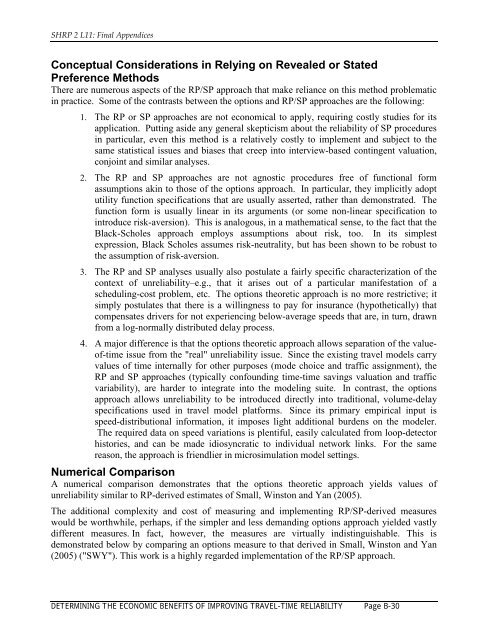Evaluating Alternative Operations Strategies to Improve Travel Time ...
Evaluating Alternative Operations Strategies to Improve Travel Time ...
Evaluating Alternative Operations Strategies to Improve Travel Time ...
You also want an ePaper? Increase the reach of your titles
YUMPU automatically turns print PDFs into web optimized ePapers that Google loves.
SHRP 2 L11: Final Appendices<br />
Conceptual Considerations in Relying on Revealed or Stated<br />
Preference Methods<br />
There are numerous aspects of the RP/SP approach that make reliance on this method problematic<br />
in practice. Some of the contrasts between the options and RP/SP approaches are the following:<br />
1. The RP or SP approaches are not economical <strong>to</strong> apply, requiring costly studies for its<br />
application. Putting aside any general skepticism about the reliability of SP procedures<br />
in particular, even this method is a relatively costly <strong>to</strong> implement and subject <strong>to</strong> the<br />
same statistical issues and biases that creep in<strong>to</strong> interview-based contingent valuation,<br />
conjoint and similar analyses.<br />
2. The RP and SP approaches are not agnostic procedures free of functional form<br />
assumptions akin <strong>to</strong> those of the options approach. In particular, they implicitly adopt<br />
utility function specifications that are usually asserted, rather than demonstrated. The<br />
function form is usually linear in its arguments (or some non-linear specification <strong>to</strong><br />
introduce risk-aversion). This is analogous, in a mathematical sense, <strong>to</strong> the fact that the<br />
Black-Scholes approach employs assumptions about risk, <strong>to</strong>o. In its simplest<br />
expression, Black Scholes assumes risk-neutrality, but has been shown <strong>to</strong> be robust <strong>to</strong><br />
the assumption of risk-aversion.<br />
3. The RP and SP analyses usually also postulate a fairly specific characterization of the<br />
context of unreliability–e.g., that it arises out of a particular manifestation of a<br />
scheduling-cost problem, etc. The options theoretic approach is no more restrictive; it<br />
simply postulates that there is a willingness <strong>to</strong> pay for insurance (hypothetically) that<br />
compensates drivers for not experiencing below-average speeds that are, in turn, drawn<br />
from a log-normally distributed delay process.<br />
4. A major difference is that the options theoretic approach allows separation of the valueof-time<br />
issue from the "real" unreliability issue. Since the existing travel models carry<br />
values of time internally for other purposes (mode choice and traffic assignment), the<br />
RP and SP approaches (typically confounding time-time savings valuation and traffic<br />
variability), are harder <strong>to</strong> integrate in<strong>to</strong> the modeling suite. In contrast, the options<br />
approach allows unreliability <strong>to</strong> be introduced directly in<strong>to</strong> traditional, volume-delay<br />
specifications used in travel model platforms. Since its primary empirical input is<br />
speed-distributional information, it imposes light additional burdens on the modeler.<br />
The required data on speed variations is plentiful, easily calculated from loop-detec<strong>to</strong>r<br />
his<strong>to</strong>ries, and can be made idiosyncratic <strong>to</strong> individual network links. For the same<br />
reason, the approach is friendlier in microsimulation model settings.<br />
Numerical Comparison<br />
A numerical comparison demonstrates that the options theoretic approach yields values of<br />
unreliability similar <strong>to</strong> RP-derived estimates of Small, Wins<strong>to</strong>n and Yan (2005).<br />
The additional complexity and cost of measuring and implementing RP/SP-derived measures<br />
would be worthwhile, perhaps, if the simpler and less demanding options approach yielded vastly<br />
different measures. In fact, however, the measures are virtually indistinguishable. This is<br />
demonstrated below by comparing an options measure <strong>to</strong> that derived in Small, Wins<strong>to</strong>n and Yan<br />
(2005) ("SWY"). This work is a highly regarded implementation of the RP/SP approach.<br />
DETERMINING THE ECONOMIC BENEFITS OF IMPROVING TRAVEL-TIME RELIABILITY Page B-30















